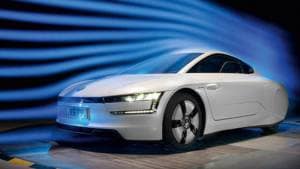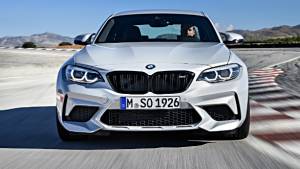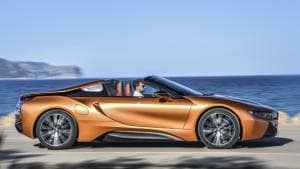BMW i8 hybrid sportscar road test review
BMW's performance cars as we know them are going through a lot of change. A few months back, we drove the new M3/M4 twins that have chucked the beautiful-sounding naturally aspirated engines for turbocharged mills that manage to be equally enticing to drive. They took the forced-induction path laid down by the new M5 a few years back.
Around the same time this M5 came out, BMW also showed the i8 concept at the Frankfurt Motor Show. An evolution of the Efficient Dynamics concept, the i8 concept looked beautiful with its low-slung stance, the see-through folds and the blue accents. But before we could archive the i8 as yet another hybrid sportscar concept, BMW did the unthinkable and put it down on the road, almost unchanged from its concept form.
 The BMW's design has hints of the M1 to it
The BMW's design has hints of the M1 to it
That has its pros and cons. One of the cons is that there are some bits that still look unfinished - like the plasticky look and feel of the kidney grille. Or the exposed carbon-fibre at the doorsills. The weave is hardly visible and the edges aren't smoothened out. The pro on the other hand is that the design elements from the concept look stunning for a production car. The silhouette is a smooth arc hinting towards the car's clean aerodynamics. There hardly are any air-dams and the flowing bodywork with the floating buttresses under the glass bootlid makes cars like the 911s or the Aston Martins look like stuff of the past. In fact, I like it so much that I can't help but wonder why BMW doesn't make enough sportscars.
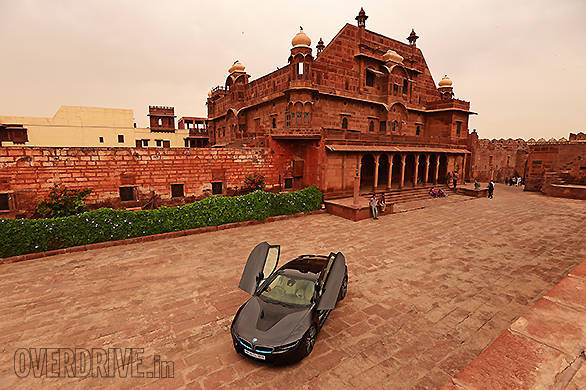
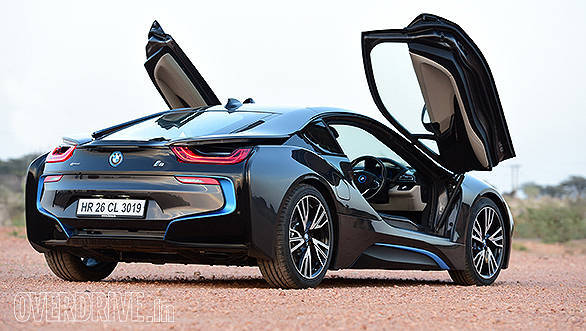 The party-trick for the i8 are the scissor doors and unlike the SLS AMG, they don't need you to stretch out as much to close them
The party-trick for the i8 are the scissor doors and unlike the SLS AMG, they don't need you to stretch out as much to close them
If you are a BMW-purist, you will also notice the M1 inspiration in the i8's stance. The bonnet is low-slung with a deep-dish scoop in the centre, the nose is sharp, the wheel-arches are slim and almost in line with the surface of the bonnet and the party trick is those scissor doors. Winged doors like the M1 would make it too much of an SLS AMG inspiration in today's times.
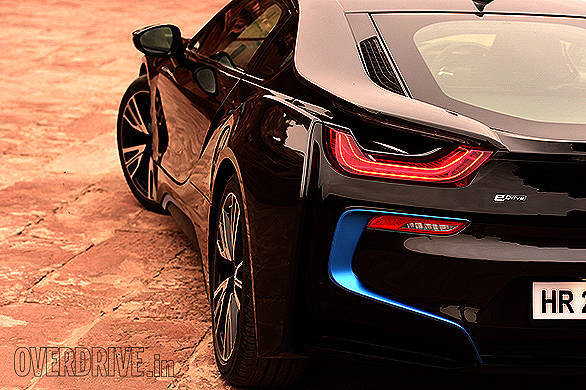 Despite the radical form, the i8 has clean lines
Despite the radical form, the i8 has clean lines
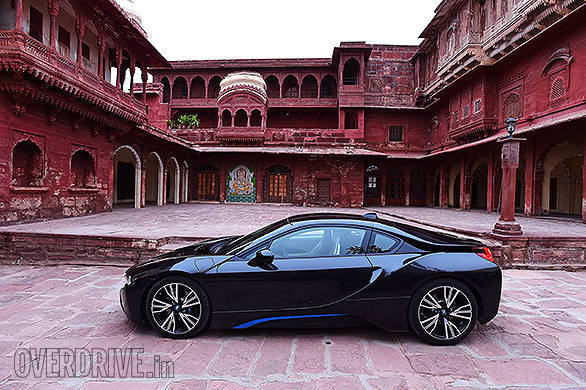
After all, this is now the flagship sportscar for BMW and because it is production spec, it comes with more colour options than the plasticky white on the concept. I love the graphite shade you see here and even the all-blue option scores high. The blue accents are standard on all i-cars from BMW and I expect to see them become a signature design element for all future BMWs that will focus on sustainable mobility.
The blue theme continues on the inside and is the choice of background colour for the two display panels that form the instrumentation and iDrive units respectively. The layout is typical BMW too, with the centre console tilted towards the driver and the cockpit virtually wrapping itself around the driver's seat. All the controls, therefore, lie easily at hand and there are very few of them too. You have the usual dial for the iDrive, HVAC, audio knobs and switches, and steering mounted switches for audio and cruise control. Even the stacked user interface for the iDrive infotainment is similar to other BMW cars, save for the different animation between menus.
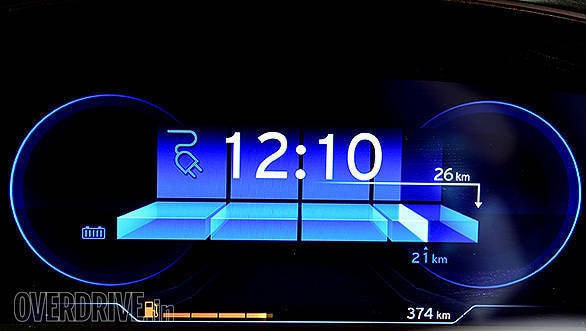 Charging the battery pack takes up to four hours and the charger requires a conventional three-pin plug
Charging the battery pack takes up to four hours and the charger requires a conventional three-pin plug
The instrumentation is an LCD display panel with two animated analogue clocks taking up most of the real estate. While one is for the speedometer, the usual tachometer is replaced by a 'power' meter that instantaneously displays how much of it is being used. The trip and odometers, buried on the lower corners of the panel, are mostly in the blind spot. There's a fuel and battery gauge too and the latter essentially shows the remaining range for pure electric propulsion, which in BMW-speak is called eDrive. The gauge has a blue arrow over it to denote the eDrive mode, which charges to yellow if the petrol engine is being used to charge up the cells.
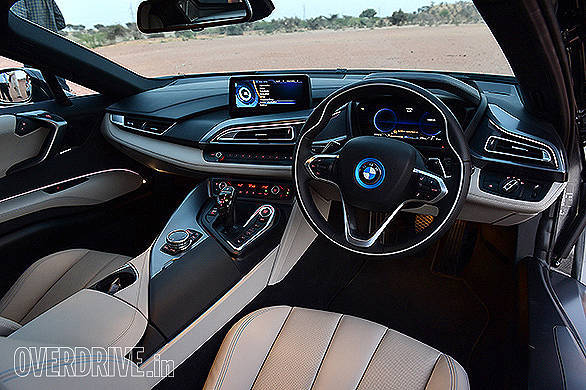 The i8 isn't a spaceship on the inside either and the cabin has a layout similar to most other Beemers
The i8 isn't a spaceship on the inside either and the cabin has a layout similar to most other Beemers
Speaking of which, the i8, being a hybrid, comes with two drivetrains. At the front wheels are electric motors powered by lithium-ion batteries and at the back is a 1.5-litre three cylinder petrol engine that powers the rear wheels. The engine comes from the base Mini petrol (not sold in India) and produces a staggering 231PS and 320Nm, courtesy twin-turbocharging. The electric motors contribute an additional 131PS and 250Nm. The combined output is good to propel the i8 from standstill to 100kmph in 4.4s. Contributing to this is a kerb weight of 1,485kg, which is impressively light for a car whose belly is full of lithium-ion batteries.
 The i8 claims to be a 2+2, but the upright seats at the back are for the kids you don't love
The i8 claims to be a 2+2, but the upright seats at the back are for the kids you don't love
So how has BMW managed so keep it so light? The answer lies in the new-age materials and production techniques. The i8 has a layered construction that BMW calls LifeDrive architecture. The 'life' end is the cabin which is the organic part as the passengers control all of it. It is a carbon-fibre tub that sits like an egg in a nest. A nest that forms the chassis of the car or the 'drive' unit. It is constructed using aluminium for most of its components. The 'layered' design make for thick lower door sills, and generously-sized drivers need to literally slide into the cabin. The door handles are within easy reach too and closing them doesn't need you to reach out like you would in the SLS AMG.
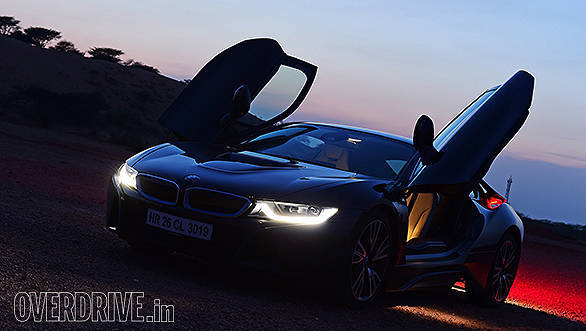 Every lighting element used in the i8 makes use of light emitting diodes (LEDs)
Every lighting element used in the i8 makes use of light emitting diodes (LEDs)
Between the egg and the nest is the bed of batteries. They take about four hours to charge completely, and if there is sufficient juice in them on start-up, the car chooses to boot in all-electric mode by default. Else, it is the petrol engine that wakes up with a hum. Starting in all-electric mode makes everything light up inside the cabin and a sonic sound like some effect from a sci-fi flick tells you that the i8 is good to move. That is your only clue as there is no vibration, exhaust note or movement to tell you otherwise. The i8 still has the typical BMW gear selector to choose between drive, reverse and neutral modes. Speaking of gears, the petrol engine has a six-speed automatic unit, while the electric motors have a two-step transmission.
The moment you get going, you will notice that the electric motors are more than eager to catapult the car. It isn't jerky, but the fact that all the torque is available on a few degrees of throttle input, makes the i8 want to plunge forward even with the slightest dab on the accelerator pedal. In pure electric propulsion, the car can reach a top whack of 120kmph and even at that speed, the i8 only uses about 60 per cent of the battery power. The car remains pretty silent through this range and the only noise inside the cabin is from the tyres and the sound from the air-conditioning unit. Unless it is breezy outside, wind noise is pretty non-existent even at 120kmph. BMW claims that the i8 will do about 35km in the eDrive mode, but the best we managed was 21km before the batteries ran out and the petrol charging kicked in for good. There is brake energy regeneration as well, but it isn't enough to bump up the electric range by any significant margin.
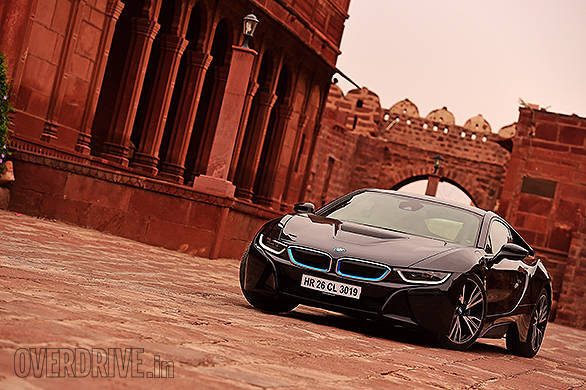
While the i8 is in motion, the petrol engine wakes up in three common scenarios - when the batteries are running out of juice; when you exceed speeds of 120kmph; or when you push the shifter left to enter the Sports mode. When the latter happens, the hue of the instrumentation transforms from blue to red and the power meter is replaced with a tachometer. The petrol motor redlines at 6,500rpm. When you do indulge in spirited driving, which you will every now and then, the battery pack acts like a power-booster in all scenarios where you need additional torque. Like the M5, the i8 too fills up the cabin with a virtual sound and the speaker is bolted between the so-called rear seats. It mimics the effect of a rear-engined sportscars running on a flat-six powertrain.
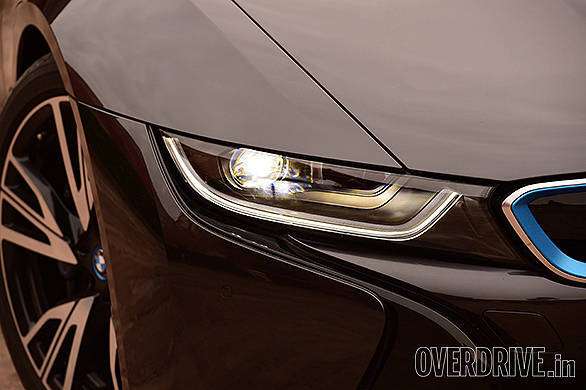 The India-spec i8 ships with LED headlamps as standard
The India-spec i8 ships with LED headlamps as standard
What is also impressive is the way the two drivetrains act like a torque-vectoring all-wheel-drive system. It makes for amazing grip when you push the i8 through corners. The linear power delivery of both the drivetrains adds more fun as you can push the i8 harder. The suspension setup is typical BMW too - stiff through corners and relatively comfortable over bumps. The ground clearance can become an issue over deep potholes or tall speed-breakers, but over our three-day drive, the underbelly never touched anything. The steering isn't typical BMW and the electrical assistance robs it of most of the feedback. It is as precise though, and surprisingly it is the only mechanical element in the sportscar that feels 'digital'. The rest of it still feels as natural as any other sportscar of our times and that's an achievement for this hybrid.
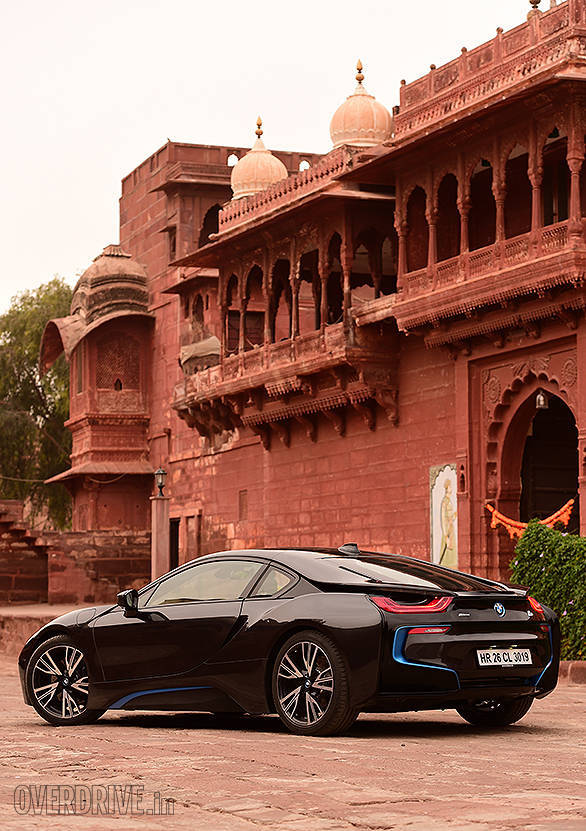
As I said, BMW sportscars are going through a lot of changes and their new flagship, this i8, is an insight into where they are headed. The extreme turbocharging, the hybrid powertrain, the new steering system, they are all results of tightening norms. Despite this, what hasn't changed is the driving pleasure that you come to expect from a Beemer. The new-age M3 and the M5 were reassuring of that fact and the i8 cements it further. It has gone digital, but is still fun to drive and is practical. What's your move then, Audi?
Location courtesy: Fort Pokhran
Images by Suresh Narayan
More from OVERDRIVE on the BMW i8:
2014 BMW i8 first drive in California
.
Starts Rs 2.62 Crore
1499cc
Automatic
361
250
-NA-
